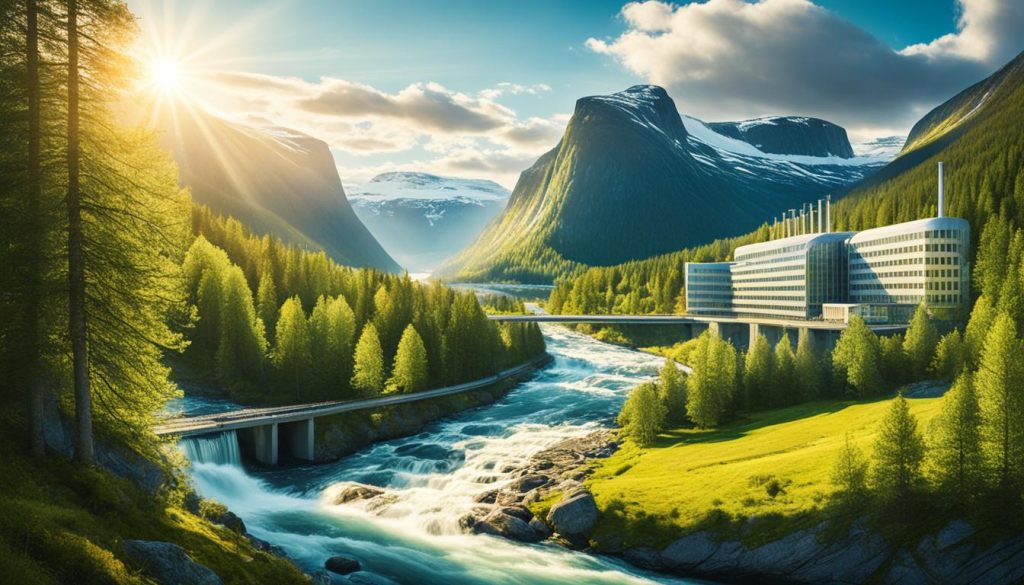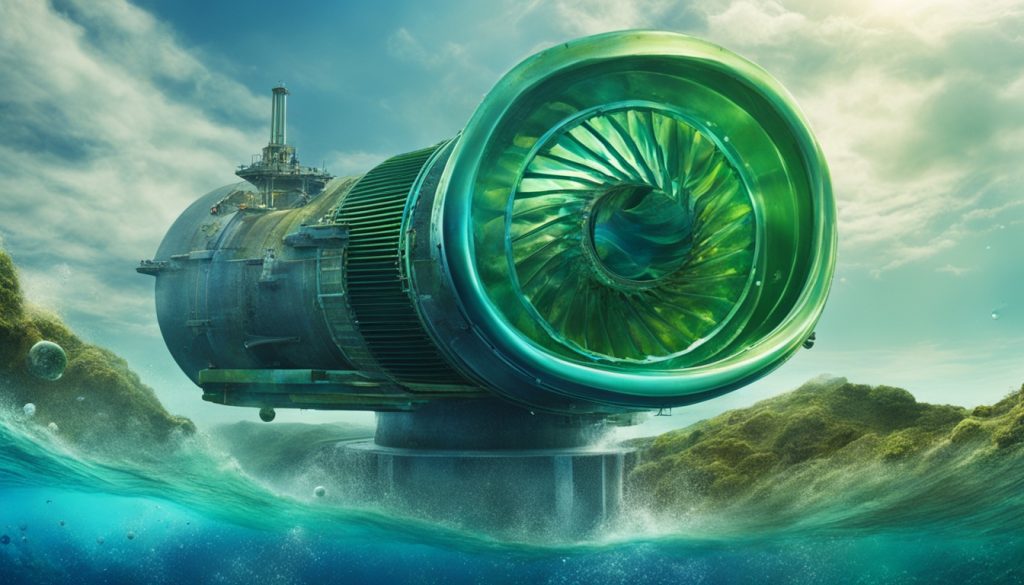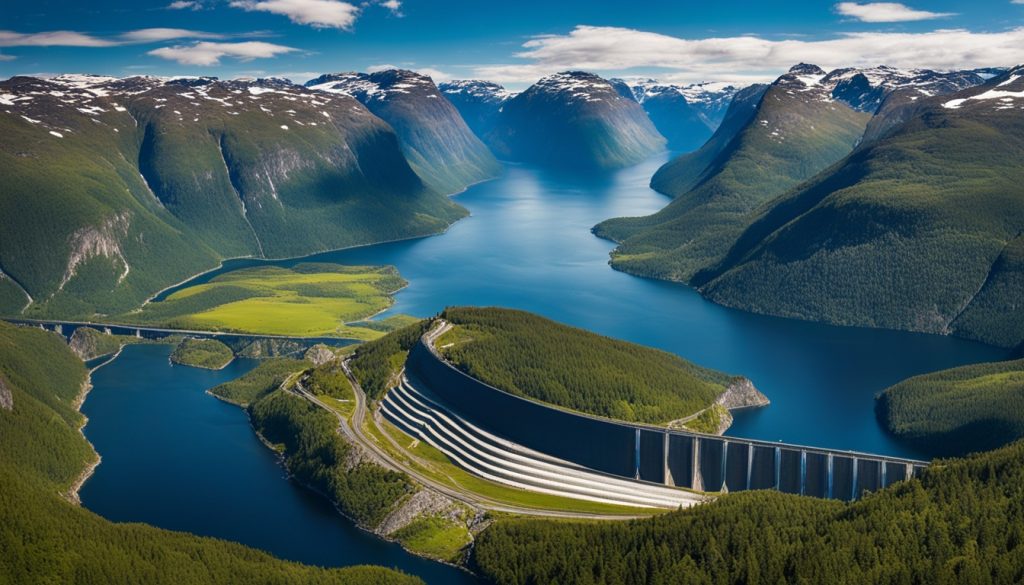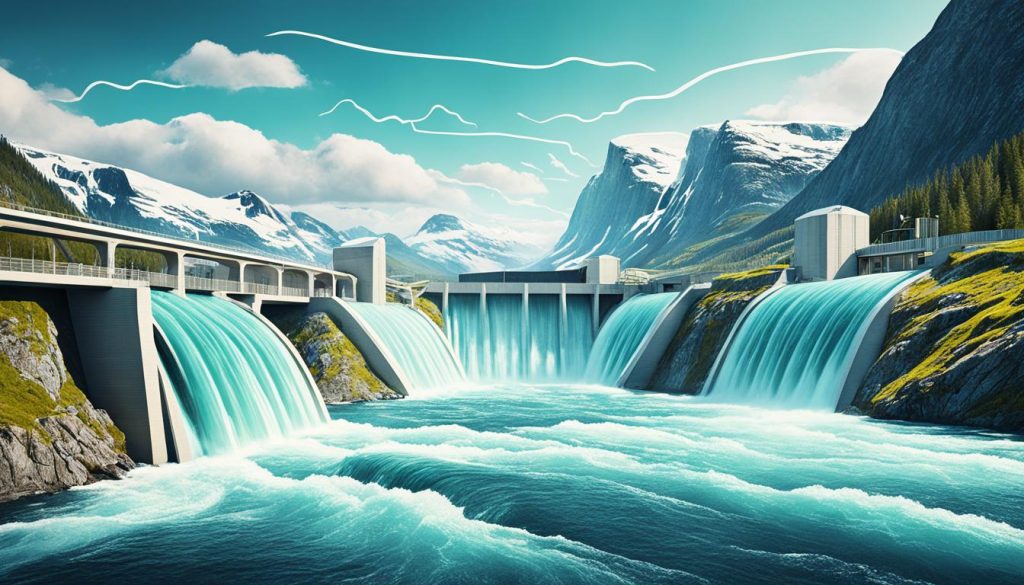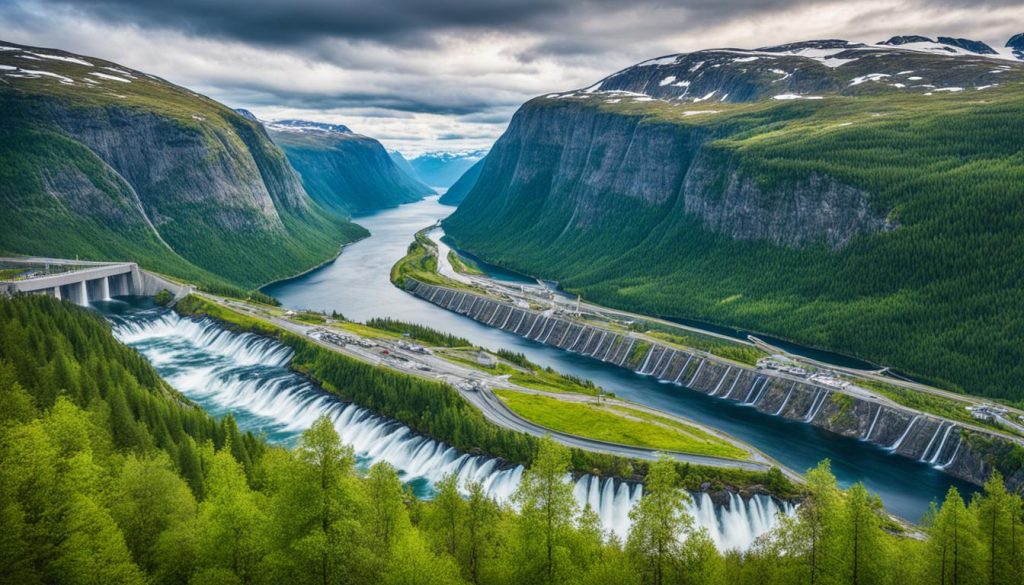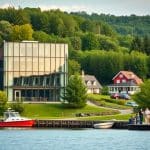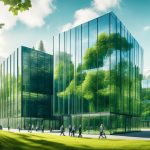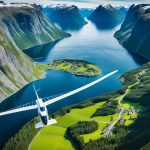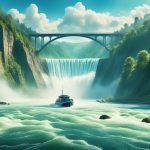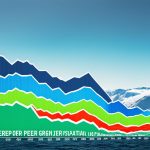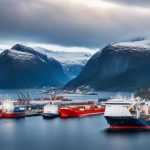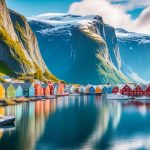“The best way to predict the future is to invent it.” – Alan Kay
Norway is a shining example in the renewable energy world. It shows us how to use what nature gives us in a smart way. The country has many hydropower plants. These plants turn the movement of water into clean energy, using modern water turbines.
These stations are great because they don’t cost much to start or stop. They can also save water in big lakes for later use. This means they can quickly change how much power they make, based on how much people need it. Norway holds about half of Europe’s ability to store green energy. This makes it a big player in keeping the continent powered.
Statkraft, a major company, manages these green power sources. They don’t just work in Norway but in many countries, showing Norway’s big role in the world of hydropower.
Key Takeaways
- Norway’s hydropower plants showcase a commitment to renewable energy through high-efficiency water turbines.
- The system’s flexibility and low operational costs ensure a consistent energy supply.
- Nearly half of Europe’s renewable storage capacity is located in Norway.
- Statkraft is a leading operator of hydropower assets, underlining Norway’s global influence in sustainable power.
- Hydropower in Norway plays a key role in Europe’s renewable energy infrastructure.
The Rich History of Norwegian Hydropower
Hydropower is deeply rooted in Norway’s past, starting with water mills. From there, Norway moved to harnessing hydroelectric power. This journey shows the country’s growth in using water for energy.
Early Beginnings: Water Wheels to Hydroelectric Power
Norway’s hydropower story began with the simple water wheel. These mills used the power of streams to do work. Over time, these methods evolved into generating electricity, changing Norway’s energy scene.
The First State-Purchased Waterfall
In 1895, a major step was taken when the government bought the Paulenfossen waterfall. This showed Norway’s strong move towards hydroelectricity. It led to investments in hydro projects, which supported the public sector, like railways.
Industrialisation and Energy Needs in Early 20th Century
The early 1900s brought rapid industrial growth to Norway, increasing the need for energy. The state then acquired more waterfalls to boost hydroelectric power. In 1921, the NVE was set up to oversee water and energy resources. This era brought important hydroelectric projects, like the Svartisen power plant, to meet energy demands.
These steps in developing hydropower are key to Norway’s energy policy. They highlight the country’s achievements and innovation in energy production.
Geography: A Perfect Fit for Hydropower
Norway’s geography is perfect for hydropower. It has steep valleys, lots of rivers, and plenty of rain. The west gets more rain. This makes the land great for producing clean energy. Because of this, Norway leads in using water for power.
Steep Valleys and Abundant Rivers
The steep valleys and many rivers in Norway help make a lot of power. The water falls quickly, creating energy. Norway uses this to make more power than many other places.
Heavy Rainfall in Western Norway
Western Norway gets a lot of rain. This means the rivers always have plenty of water. It helps Norway make power in a way that’s good for the planet and reliable.
Modern Technological Advances in Hydropower Stations
Norway’s hydropower sector is changing greatly thanks to hydropower innovation. These changes help Norway stay a leader in renewable energy.
Renewable Energy Certificates and Small-Scale Projects
Renewable Energy Certificates are key to promoting small hydropower projects. They’ve greatly helped roll out many small projects. These projects boost Norway’s renewable energy and support sustainable power goals.
Testing Sea-Bed Tidal Energy
Norway’s Hammerfest Strøm is leading with sea-bed turbine tests. The aim is to turn tidal energy into electricity. This experiment shows Norway’s effort to use different renewable energy sources.
The Air-Cushioned Surge Chamber
NTNU’s Waterpower Laboratory has created the air-cushioned surge chamber. This innovation makes hydropower stations more responsive. It shows Norway’s leadership in hydropower certification and innovation.
These innovations show Norway’s commitment to improving hydropower. From small projects to sea-bed turbine tests and new technology, Norway’s hydropower future looks bright.
Statkraft: A Major Player in Norwegian Hydropower
Statkraft leads the way in Norway’s hydroelectric scene, known for its global work. This company has projects in many countries, making it a key name in renewable energy.
It’s not just in Norway where Statkraft makes a difference. They’re big in Sweden, Germany, and the UK too. They control a lot of Europe’s hydropower, which helps the continent use more green energy.
Moreover, Statkraft is all about green investments. They are a big name in clean energy, not just in Norway, but worldwide. Their work helps push the world towards a greener future.
Environmental Sustainability and Hydropower
Hydropower is key for a sustainable future. It uses natural water flows and pairs well with wind and solar energy. Its ability to be regulated makes it a strong ally for a stable energy grid.
Hydropower’s Role in a Renewable Future
Norway leads with hydropower for clean electricity with low emissions. It balances nature with energy needs and pushes green technology forward. Plus, it’s great for storing energy, helping when sun or wind isn’t enough.
Hydropower and Nature: A Harmonious Relationship
Hydropower works well with nature, keeping balance. In Norway, careful planning protects wildlife while making clean energy. This approach shows we can power our world without harming it.
Norway’s Hydropower Capacity and Global Ranking
Norway is famous for producing renewable electricity, with 98% of its power coming from renewable sources. Most of this is hydropower. This outstanding fact makes Norway one of the world leaders in renewable electricity production.
98% Electricity from Renewable Sources
Norway is deeply committed to using sustainable energy. Hydropower is at the heart of its energy policy. The country uses its vast water resources and strong infrastructure to generate clean energy.
Europe’s Largest Renewable Storage Facility
Norway is ahead in the hydropower field because of its huge reservoir capacity. This makes it Europe’s top renewable storage spot. These facilities provide stable and efficient energy storage for Norway and help Europe’s renewable systems work better.
Øvre Forsland: A Modern Architectural Marvel
Øvre Forsland power station is a perfect example of hydropower design merging with nature. Its structure produces clean energy and improves the landscape, showing technology and beauty can coexist.
Design and Integration with Nature
The design of the station carefully considers its location. It creates a beautiful balance between man-made structures and nature. This not only keeps Helgeland beautiful but also teaches how sustainable materials can be wisely used.
Community and Education
Øvre Forsland is more than a power station; it’s a community hub. It provides energy and brings people together. Through educational projects, it helps both locals and visitors learn about hydropower. This spreads awareness about the environment and clean energy.
Kebony Wood and Sustainability
The use of Kebony wood shows a strong commitment to eco-friendly construction. This material is durable and needs little upkeep, fitting Norway’s environmental goals. Øvre Forsland stands as proof that infrastructure can be effective, beautiful, and sustainable.
Norway’s Hydropower Impact on Europe
Norway’s vast hydropower capabilities are crucial for Europe’s energy needs. The country uses advanced interconnectors for smooth energy transfer to neighbours. This makes the energy grid across Europe more robust and eco-friendly.
Interconnectors with the UK and Germany
Creating interconnectors with the UK and Germany marks a big achievement. These links let Norway send extra hydropower to other European regions. It helps increase Norway’s energy storage and aids the UK and Germany in reaching green energy goals. Together, they aim for a greener tomorrow.
Hydropower as a Green Battery for Europe
Norway is called Europe’s ‘green battery’ because of its renewable energy management. Its trade in hydropower, using the latest technology, Lets Europe store and use extra solar and wind energy. This makes Europe’s energy system more resilient and adaptable.
Increased Export Capacity
Boosting export capacity highlights Norway’s role in green energy. With big investments in their infrastructure, Norway is increasing its hydropower exports. This growth not only helps Norway’s economy but also stabilizes European energy supply. It ensures a steady flow of clean energy across borders.
Economic Benefits of Hydropower for Norway
Norway’s hydropower industry is a major economic force. It brings a hefty national economic contribution. By using large-scale hydropower reservoirs, Norway meets its energy needs. This also significantly increases its hydroelectricity revenue.
Key to Norway’s strategy is exporting electricity. This takes advantage of its vast water resources. Such exports boost industrial growth. They also put Norway at the forefront of renewable industry growth.
Norway taps into its hydropower to boost its economy. This creates a strong link between using resources at home and selling power abroad. It shows how Norway’s hydropower benefits its economy and drives innovation.
Case Studies of Notable Hydropower Plants
Norway is pushing boundaries with its hydropower projects. Cases like the Svartisen plant and Hammerfest Strøm’s tidal energy studies stand out. They show how Norway is finding new ways to get sustainable energy.
The Svartisen Power Plant
Located in Northern Norway, the Svartisen plant is a top example of renewable energy success. It uses water from glaciers to make electricity. This method is both effective and kind to the environment.
The plant plays a key role in Norway’s energy plan. It’s a major player in making the country’s energy cleaner.
Hammerfest Strøm Tidal Energy Test
Hammerfest Strøm is exploring tidal energy in Norway. Their project in the sea uses the power of ocean currents to produce electricity. It’s a look into using the sea for clean energy.
This study shows the potential of tidal power. It’s part of Norway’s effort to use more types of renewable energy. The work by Hammerfest Strøm is helping to shape the future of green tech.
The Future of Hydropower in Norway
Norway is a leader in renewable energy, thanks to its focus on hydropower. The nation is always looking for ways to boost energy through new tech. An example is the air-cushioned surge chamber. Norway’s drive for sustainable growth keeps hydropower as its energy backbone.
Government support is key to Norway’s success in hydropower. The country smartly mixes hydropower with other renewables. This strategy not only increases energy but also shows hydropower’s consistency. Norway’s innovative steps strengthen its status as a renewable energy leader, inspiring others worldwide.
Small, Medium, and Large Scale Hydropower Projects
Norway excels with its range of hydropower projects, from small to large. This mix lets the country answer to both local and national energy needs. By using different hydropower sizes, Norway uses its landscape well.
The country has a strong hydroelectric system. It provides consistent energy everywhere. Small and large projects ensure the renewable energy supply is always on.
Norway’s energy projects are flexible. This helps meet changing energy needs. Thus, the country leads in managing hydropower efficiently.
Norway is Home to Many Hydropower Plants
Norway shines as a top player in renewable energy, thanks to its 1,166 hydroelectric plants. This shows Norway’s big commitment to making electricity from water. It ensures both local and global markets get clean, reliable energy.
Norway’s big collection of power stations meets its energy needs in an eco-friendly way. These plants are spread out, using natural water flows. This makes the process good for the environment and efficient.
The large network of hydropower in Norway is also key in spreading out energy use. It puts Norway at the forefront of renewable energy. The country’s efforts to grow and keep up this network highlight their smart plan for eco-friendly power.
Technological Innovations at NTNU’s Waterpower Laboratory
The NTNU Waterpower Laboratory is a front-runner in hydropower research, pushing the boundaries of efficiency and design in renewable energy. Its work has led to major advancements. Let’s explore the key achievements and innovations of this respected institution.
Research and Development Over the Years
Years of research and development have marked NTNU Waterpower Laboratory’s journey. It’s a place where groundbreaking technologies come to life. These technologies have vastly improved hydroelectric plants’ efficiency. NTNU stands out globally, thanks to its contributions to hydropower projects.
Efficiency Improvements in Hydropower
The lab’s efforts in enhancing energy efficiency have made a big difference in hydropower. These improvements have boosted current power stations and inspired new advancements. NTNU’s team is creating higher efficiency standards, showing the impact of innovative research on renewable energy.
A Sustainable Electrical Grid: The Role of Hydropower
In Norway, hydropower is key for keeping the electricity grid stable. It helps add other renewable sources like wind and solar. Thanks to its flexibility, hydropower can adjust to changes, making sure power supply stays constant.
Hydropower is vital for moving towards sustainable energy. It can adjust its power output swiftly. This is crucial for keeping the grid steady as we use more renewable energy.
Additionally, hydropower boosts the electrical grid’s sustainability through energy storage. Reservoirs store extra energy when demand is low. Then, they release it when more power is needed. This process makes the power system more sustainable and reliable.

